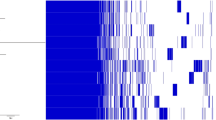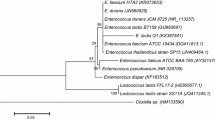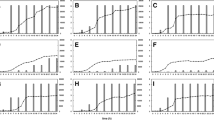Abstract
Enterococcus faecium CWBI-B1430 and Enterococcus mundtii CWBI-B1431 from artisanal-produced Peruvian cheeses showed the presence of 4 putative bacteriocin genes: enterocin A, enterocin B, enterocin P, and mundticin KS. The multiple bacteriocin producer E. faecium CWBI-B1430 presented 1 plasmid of 34.6 kb, whereas E. mundtii CWBI-B1431 contained 1 plasmid of 11.0 kb. The structural gene responsible for mundticin KS production was located on 5.6 and 3.1 kb HindIII plasmid fragments. The reverse transcription-PCR analysis showed the expression of the bacteriocin genes enterocin A, enterocin B, and mundticin KS in E. faecium CWBI-B1430 and the bacteriocin genes enterocin P and mundticin KS in E. mundtii CWBI-B1431. To our knowledge, this is the first report of the expression of mundticin KS in E. faecium and enterocin P in E. mundtii.
Similar content being viewed by others
Referencies
Franzetti L, Pompei M, Scarpellini M, Galli A. Phenotypic and genotypic characterization of Enterococcus spp. of different origins. Curr. Microbiol. 49: 255–260 (2004)
Giraffa G. Functionality of enterococci in dairy products. Int. J. Food Microbiol. 88: 215–222 (2003)
Lim S, Park M, Chang D. Characterization of bacteriocin produced by Enterococcus faecium MJ-14 isolated from meju. Food Sci. Biotechnol. 14: 49–57 (2005)
Ben Belgacem Z, Ferchichi M, Prévost H, Dousset X, Manai M. Screening for anti-listerial bacteriocin-producing lactic acid bacteria from ‘Gueddid’ a traditionally Tunisian fermented meat. Meat Sci. 78: 513–521 (2007)
Foulquié M, Sarantinopoulos P, Tsakalidou E, De Vuyst L. The role and application of enterococci in food and health. Int. J. Food Microbiol. 106: 1–24 (2006)
Franz CH, Van Belkum M, Holzapfel W, Abriouel H, Gálvez A. Diversity of enterococcal bacteriocins and their grouping in a new classification scheme. FEMS Microbiol. Rev. 31: 293–310 (2007)
Ghrairi T, Frere J, Berjeaud J, Manai M. Purification and characterisation of bacteriocins produced by Enterococcus faecium from Tunisian rigouta cheese. Food Control 19: 162–169 (2008)
Aguilar-Galvez A, Dubois-Dauphin R, Ghalfi H, Campos D, Thonart P. Description of two Enterococcus strains isolated from traditional Peruvian artisanal-produced cheeses with a bacteriocin-like inhibitory. Biotechnol. Agron. Soc. 13: 349–356 (2009)
Heilig J, Elbing K, Brent R. Large-scale preparation of plasmid DNA. pp.1.7.9–1.7.10. In: Current Protocols in Molecular Biology. Ausuhel F, Brent R, Kingston R, Moore D, Seidman J, Smith J, Struhl K (eds). John Wiley and Sons, New York, NY, USA (2002)
Park S, Itoh K, Fujisawa T. Characteristics and identification of enterocins produced by Enterococcus faecium JCM 5804T. J. Appl. Microbiol. 95: 294–300 (2003)
Foulquié M, Callewaert R, Devreese B, Van Beeumen J, De Vuyst L. Isolation and biochemical characterization of enterocins produced by enterococci from different sources. J. Appl. Microbiol. 94: 214–229 (2003)
Cintas L, Casaus P, Herranz C, Sigve L, Holo H, Hernández P, Nes I. Biochemical and genetic evidence that Enterococcus faecium L50 produces enterocins L50A and L50B, the sec-dependent enterocin P, and a novel bacteriocin secreted without an N-terminal extension termed enterocin Q. J. Bacteriol. 182: 6806–6814 (2000)
Gutierrez J, Criado R, Citti R, Martín M, Herranz C, Nes I, Cintas L, Hernández P. Cloning, production, and functional expression of enterocin P, a sec-dependent bacteriocin produced by Enterococcus faecium P13, in Escherichia coli. Int. J. Food Microbiol. 103: 239–250 (2005)
Saavedra L, Minahk C, Ruiz A, Sesma F. Enhancement of the enterocin CRL35 activity by a synthetic peptide derived from the NH2-terminal sequence. Antimicrob. Agents Ch. 48: 2778–2781 (2004)
Zendo T, Eungruttanagorn N, Fujioka S, Tashiro Y, Nomura K, Sera Y, Kobayashi G, Nakayama J, Ishizaki A, Sonomoto K. Identification and production of a bacteriocin from Enterococcus mundtii QU 2 isolated from soybean. J. Appl. Microbiol. 99: 1181–1190 (2005)
Kawamoto S, Shima J, Sato R, Eguchi T, Ohmomo S, Shibato J, Horikoshi N, Takeshita K, Sameshima T. Biochemical and genetic characterization of mundticin KS, an antilisterial peptide produced by Enterococcus mundtii NFRI 7393. Appl. Environ. Microb. 68: 3830–3840 (2002)
Aymerich T, Holo H, Håvarstein L, Hugas M, Garriga M, Nes I. Biochemical and genetic characterization of enterocin A from Enterococcus faecium, a new antilisterial bacteriocin in the pediocin family of bacteriocins. Appl. Environ. Microb. 62: 1676–1682 (1996)
Cintas L, Casaus P, Håvarstein L, Hernández P, Nes I. Biochemical and genetic characterization of enterocin P, a novel sec-dependent bacteriocin from Enterococcus faecium P13 with a broad antimicrobial spectrum. Appl. Environ. Microb. 63: 4321–4330 (1997)
Casaus P, Nilsen T, Cintas L, Nes I, Hernández P, Holo H. Enterocin B, new bacteriocin from Enterococcus faecium T136 which can act synergistically with enterocin A. Microbiology 143: 2287–2294 (1997)
Cintas L, Casaus P, Fernández M, Hernández P. Comparative antimicrobial activity of enterocin L50, pediocin PA-1, nisin A, and lactocin S against spoilage and foodborne pathogenic bacteria. Food Microbiol. 15: 289–298 (1998)
O’Keeffe T, Hill C, Ross P. Characterization and heterologous expression of the genes encoding enterocin A production, immunity, and regulation in Enterococcus faecium DPC1146. Appl. Environ. Microb. 65: 1506–1515 (1999)
Du Toit D, Franz C, Dicks L, Holzapfel W. Preliminary characterization of bacteriocins produced by Enterococcus faecium and Enterococcus faecalis isolated from pig faeces. J. Appl. Microbiol. 88: 482–494 (2000)
Ennahar S, Asou Y, Zendo T, Sonomoto K, Ishizaki A. Biochemical and genetic evidence for production of enterocins A and B by Enterococcus faecium WHE 81. Int. J. Food Microbiol. 70: 291–301 (2001)
Herranz C, Casaus P, Mukhopadhyay S, Martínez J, Rodríguez J, Nes I, Hernández P, Cintas L. Enterococcus faecium P21: A strain occurring naturally in dry-fermented sausages producing the class II bacteriocins enterocin A and enterocin B. Food Microbiol. 18: 115–131 (2001)
Mareková M, Lauková A, De Vuyst L, Skaugen M, Nes I. Partial characterization of bacteriocins produced by environmental strain Enterococcus faecium EK13. J. Appl. Microbiol. 94: 523–530 (2003)
Cocolin L, Foschino R, Comi G, Grazia M. Description of the bacteriocins produced by two strains of Enterococcus faecium isolated from Italian goat milk. Food Microbiol. 24: 752–758 (2007)
Lauková A, Czikková S, Vasilková Z, Juriš P, Mareková M. Occurrence of bacteriocin production among environmental enterococci. Lett. Appl. Microbiol. 27: 178–182 (1998)
Bennik M, Vanloo B, Brasseur R, Gorris L, Smid E. A novel bacteriocin with a YGNGV motif from vegetable-associated Enterococcus mundtii: Full characterization and interaction with target organisms. Biochim. Biophys. Acta 1373: 47–58 (1998)
Campos C, Rodríguez O, Calo-Mata P, Prado M, Barros-Velázquez J. Preliminary characterization of bacteriocins from Lactococcus lactis, Enterococcus faecium, and Enterococcus mundtii strains isolated from turbot (Psetta maxima). Food Res. Int. 39: 356–364 (2006)
Ferreira A, Canal N, Morales D, Bopp D, Corção G. Characterization of enterocins produced by Enterococcus mundtii isolated from humans feces. Braz. Arch. Biol. Techn. 50: 249–258 (2007)
Criado R, Gutiérrez J, Martín M, Herranz C, Hernández C, Cintas L. Immunochemical characterization of temperature-regulated production of enterocin L50 (EntL50A and EntL50B), enterocin P, and enterocin Q by Enterococcus faecium L50. Appl. Environ. Microb. 72: 7634–7643 (2006)
Abriouel H, Ben Omar N, Lucas R, Martínez-Cañamero M, Gálvez A. Bacteriocin production, plasmid content, and plasmid location of enterocin P structural gene in enterococci isolated from food sources. Lett. Appl. Microbiol. 42: 331–337 (2006)
Aymerich T, Artigas M, Garriga M, Monfort J, Hugas M. Effect of sausage ingredients and additives on the production of enterocins A and B by Enterococcus faecium CTC492. Optimization of in vitro production and anti-listerial effect in dry fermented sausages. J. Appl. Microbiol. 88: 686–694 (2000)
Drider D, Fimland G, Héchard Y, McMullen L, Prévost H. The continuing story of class IIa bacteriocins. Microbiol. Mol. Biol. R. 70: 564–582 (2006)
Franz C, Worobo R, Quadri L, Schillinger U, Holzapfel W, Vederas J, Stiles M. Atypical genetic locus associated with constitutive production of enterocin B by Enterococcus faecium BFE 900. Appl. Environ. Microb. 65: 2170–2178 (1999)
Quadri L, Yan L, Stiles M, Vederas J. Effect of amino acid substitutions on the activity of carnobacteriocin B2. J. Biol. Chem. 272: 3384–3388 (1997)
Van Belkum M, Stiles M. Nonlantibiotic antibacterial peptides from lactic acid bacteria. Nat. Prod. Rep. 17: 323–365 (2000)
Author information
Authors and Affiliations
Corresponding author
Rights and permissions
About this article
Cite this article
Aguilar-Galvez, A., Dubois-Dauphin, R., Campos, D. et al. Genetic determination and localization of multiple bacteriocins produced by Enterococcus faecium CWBI-B1430 and Enterococcus mundtii CWBI-B1431. Food Sci Biotechnol 20, 289–296 (2011). https://doi.org/10.1007/s10068-011-0041-6
Received:
Revised:
Accepted:
Published:
Issue Date:
DOI: https://doi.org/10.1007/s10068-011-0041-6




